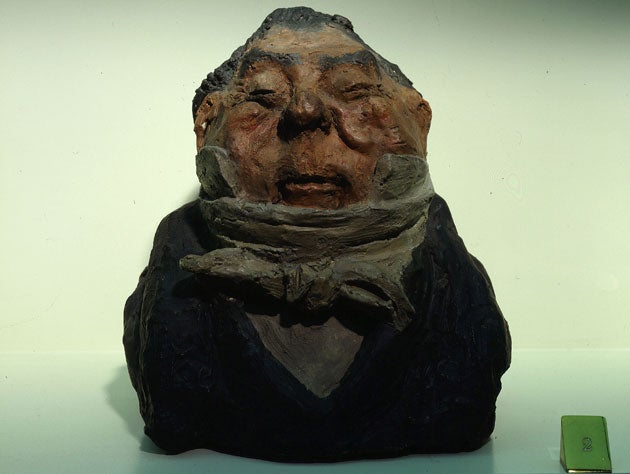Great Works: Charles Guillaume Etienne: The Vain Man, 1832 (15.9cm high), Honoré Daumier
Musee d'Orsay, Paris

Clay is desperately undervalued as a medium for art. Works by the greatest of ceramicists often command near derisory prices at the auction house. So it is easy to overlook a small work in clay, and especially when it is one among many ranged side by side on a shelf, production-line style, amid a great collection such as the Musée d'Orsay's in Paris – which is not to praise the establishment itself, I hasten to add, which is one of the most wretched conversions of an industrial building into a mecca of high art of the second half of the 20th century.
This tiny caricature of a forgotten playwright and politician called Charles-Guillaume Etienne, barely more than an adult hand's span in height, was made by Honoré Daumier, one of the greatest of all practitioners of the art of poking fun and getting into serious trouble for doing so. He served a term of six months in prison for one of his bold attacks upon Louis Philippe.
Daumier is renowned for his prints – he made about 4,000 of them during his prolific lifetime. The series of caricatures that you can see displayed in this functional row, behind glass, on the ground floor at the d'Orsay – as if they were tossed off at great speed, one after another, to please the artist himself – are something altogether different. They are faster, less finicky, and often much funnier. They also come entirely uncluttered by incidental embellishment. They are types of human beings in the raw.
The title of this work is The Vain Man, and Daumier is at pains to show off this self-vaunting individual as nothing more nor less than what the limits of that title encompass. The making is rude and crude. This work has not been been fired in the kiln. It has been manipulated by Daumier's deft hands, and then hand-painted. The effects of colour are brilliant, but strictly limited. No harm in that though – what this piece requires by way of colour is an impression of a kind of overwhelming dullness, and that is precisely what Daumier achieves. This is a piece of tobyjugglery, which rises to a much higher level because it is so brilliantly and preposterously individualised. We fully understand the meaning of swell-headed as we stare at it.
Let us begin with that fat, grey bow (which is evidently the knotted end of a cravat), perfectly centred at the front of his neck. Its flourish suggests that this man is something of a gift to himself – and what better gift could a man of such and such pretensions want than himself? The fleshy and ever swelling neck seems jammed, squeezed into that throttling cravat. The cheeks distend only as far as the high collar – that tall, stiff, grey wall – will permit them to go. The collar constrains an overwhelming abundance of slopping and spilling flesh. It gives all that otherwise shapeless fleshiness a certain form, if not a limit. It even appears to squeeze these cheeks into folds or crude, hillock-like ructions that almost press against the nose, which seems to be extruding out towards us like a fat, gradually unlooping, worm-like thing.
The nose is darker than the surrounding flesh, deep with the rubicundity brought on by overmuch scoffing and swilling. There appear to be areas of rouging where the flesh rises, as if to suggest that the man has been applying dibs and dabs of make-up to himself in order to enhance the generally favourable public perception – as he believes – of his own favourable qualities. The fact is that he is virtually blind to his own grotesquely ill-favoured appearance, as those tiny, narrowed, heavily-lidded eyes seem to suggest. He does not need to see how and what he is – he knows that already. He knows what a man of gravity he is said to be.
There is a tremendous display of deportment in this head, and the way it is being carried along – very slow-movingly, dromedary-like, we imagine – on this neck, with such care. The eyebrows arch above the eyes like great escarpments, and then we come to the bathetically flat, narrow plain of the forehead, which is immediately beneath the top of the head. There is a strange triangle here, that slope up from temple to the very top.
The head looks hugely broad at the level of the cheeks and preposterously narrow at the top. We have not yet remarked upon those pert and rather sloppily wet-looking little lips, which appear to be just about to open in a witticism – or to have just closed on one, to huge applause. This helps to animate the face – a trick that Daumier may have learnt from the great Bernini. We are left speechless by this piece. Much, much, much later we may hazard a quick glance in the mirror.
ABOUT THE ARTIST
Honoré Daumier (1808-79) was among the greatest of 19th-century French caricaturists. He feared nothing. He even took on the might of a reigning king, and was imprisoned for his pains. Lithography was the medium in which he worked most regularly. These tiny busts were made to please himself.
Join our commenting forum
Join thought-provoking conversations, follow other Independent readers and see their replies
Comments